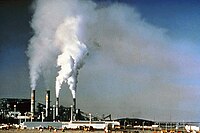
Photo from wikipedia
The main component of flue gas desulfurization (FGD) gypsum is CaSO4·2H2O, a type of salt. However, excess of this material poses a hazard to crop emergence and growth. Thus, a… Click to show full abstract
The main component of flue gas desulfurization (FGD) gypsum is CaSO4·2H2O, a type of salt. However, excess of this material poses a hazard to crop emergence and growth. Thus, a pot experiment was carried out in which sandy loam soil collected from a typical sodic soil distribution area in Northeast China was used. Sunflower (Helianthus annuus L.) and maize (Zea mays L.) seeds were sown directly into highly sodic soil (whose pH was 9.1 and exchangeable sodium percentage was 31.5%), FGD gypsum, or a mixture of the two (mass ratio of 1:1). Drainage was prevented, and no fertilizer was applied. Unexpectedly, all sunflower seeds emerged and grew in all three media. The growth of plants in the FGD gypsum was inhibited mainly because of the reduced available nutrient contents, which resulted in significantly lower plant height, root length, and biomass compared with those of plants grown in the other two media. In contrast, the sodic soil and FGD gypsum mixture effectively alleviated the salt- and nutrient-related issues, and the plants displayed robust germination and growth. A similar trend occurred for maize, although both the germination percentage and survival rate were lower than those of sunflower. After growing for 30 days, sunflower plants in the sodic soil had significantly greater activities of superoxide dismutase and contents of malondialdehyde but lower activities of catalase and peroxidase in the leaves compared with those of plants in the other two media. These results provide convincing evidence that sunflower and maize can grow directly in FGD gypsum, and the potential hazardous effects of this media on plants were lower than those associated with soil salinity and sodicity.
Journal Title: Journal of Soil Science and Plant Nutrition
Year Published: 2020
Link to full text (if available)
Share on Social Media: Sign Up to like & get
recommendations!